
An atmospheric river will bring heavy rainfall to lower elevations of California this week, and heavy snow to the Sierra Nevada mountains. Flash flooding, some of which may be locally considerable, will be a concern on the western foothills of the Sierra Nevada mountains through Tuesday. Landslides, rockfalls and mudslides are possible in the Southern California mountains. Read More >
Overview
|
On Wednesday, April 10, a band of heavy snow developed in advance of a low pressure system over the Plains and lifted north across the region slowly during the day. It produced 1 to 2 inches of snow an hour at times and was even accompanied by lightning and thunder across southern Minnesota. Another band developed over Iowa during the evening and lifted north overnight, producing another round of thundersnow and hourly snow rates of 1 to 2 inches early Thursday morning. Most of the snow occurred with these two rounds. Snowfall totals of 6 to 12 inches were common. Warmer air aloft begin to arrive Thursday morning across southern Minnesota, causing the snow to turn to a wintry mix of sleet, snow, and rain. Even as surface temperatures remained below freezing, a few severe thunderstorms developed Thursday morning over Steele, Renville, Redwood, Chippewa, and Yellow Medicine counties as the warm air aloft produced elevated instability. Quarter size hail was reported with all three storms. The worst of the wind occurred Thursday. East winds gusting between 50 and 65 mph resulted in 650+ damaged power poles and hundreds of lines down. The Associated Press reported 100,000 people in Minnesota, South Dakota, Iowa, and Wisconsin had lost power. The wind also produced widespread blizzard conditions across western Minnesota, where most of the precipitation remained snow throughout the event. By Thursday night, winds began to subside and the precipitation was more patchy. A final round of snow occurred Friday morning on the backside of the low, with another inch or two falling. This storm pushed Eau Claire's seasonal snowfall into record territory at 98.8 inches. The previous record was 89.3 inches from the 1996-97 season.
|
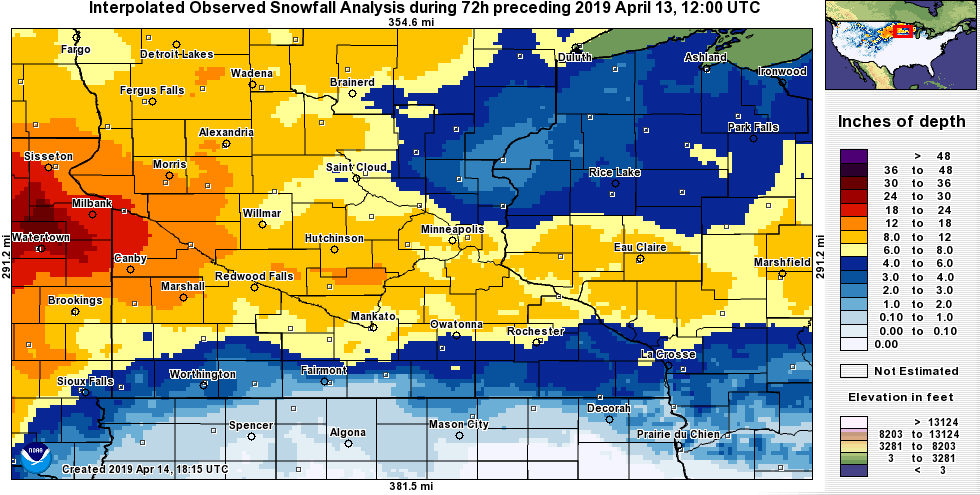 Map of observed snowfall from April 10-12. The yellow shading shows amounts over 6 inches, and the orange shading shows amounts in excess of a foot. The snow was difficult to measure due the very strong winds that accompanied this storm and the change over to various precipitation types. |
Travel Impacts
This winter storm brought significant travel impacts across Minnesota and Wisconsin. Several state roads across southwestern MN were closed, as was I-35 across a portion of southern Minnesota due to numerous accidents along that stretch.
 |
| Road conditions across Minnesota and western Wisconsin at noon on April 12. MNDOT and WisDOT were advising no travel in the purple areas of southwestern Minnesota and west central Wisconsin. |
Photos
 |
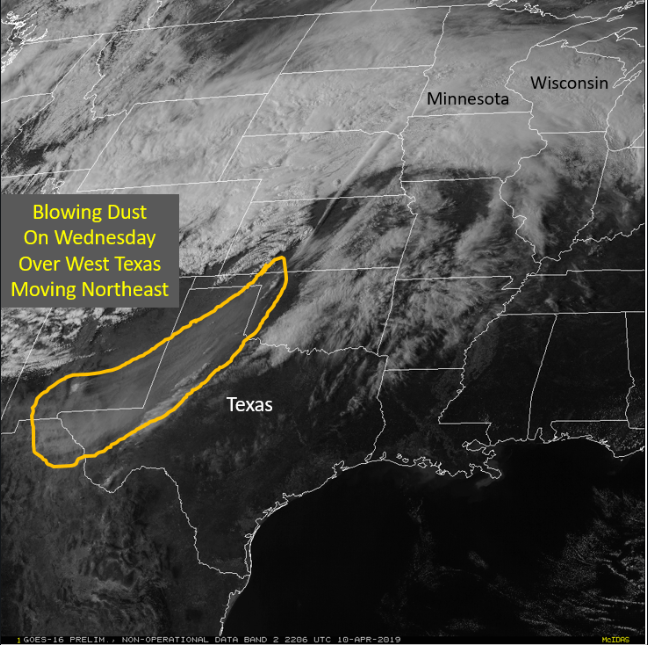 |
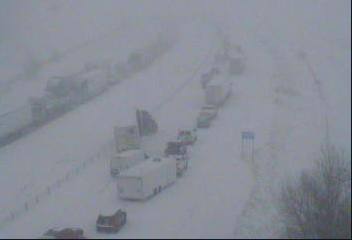 |
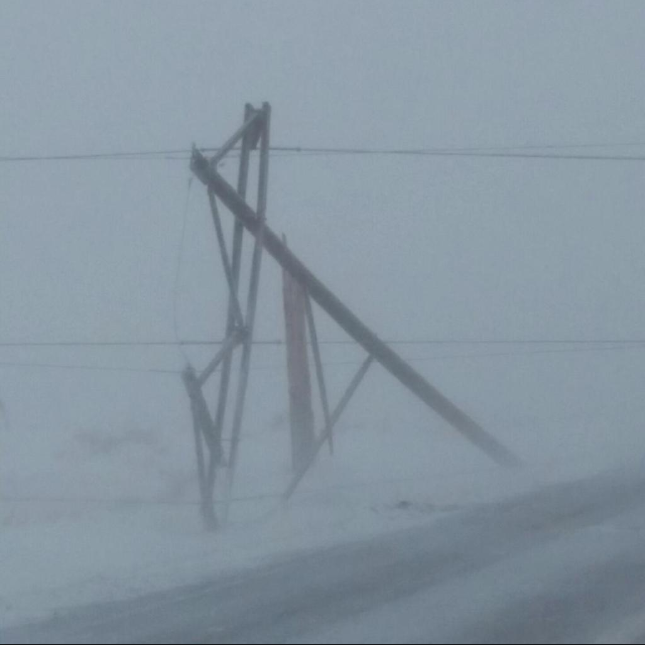 |
 |
| The snow had a reddish brown tint to it thanks to dust from the south. Photo courtesy of Tim Lundahl. | Satellite captured the blowing dust over west Texas and southeastern New Mexico. The dust was lofted to the jet stream level and transported northward, mixing with the falling snow. | The initial band of heavy snow produced numerous accidents along I-35 from Medford to Faribault, resulting in a closure of the interstate for a time. Photo courtesy of MnDOT. | . Strong winds resulted in 650+ power poles damaged and hundreds of lines down. Photo courtesy of Xcel Energy. | Another power pole snapped due to the strong wind. Photo courtesy of Cory Green. |
Meteorology and Radar
A strong low pressure system developed over Colorado and tracked east across Kansas, then northward along the Nebraska/Iowa border and northeast across the Upper Midwest. The maps below are the official Weather Prediction Center's surface analysis.
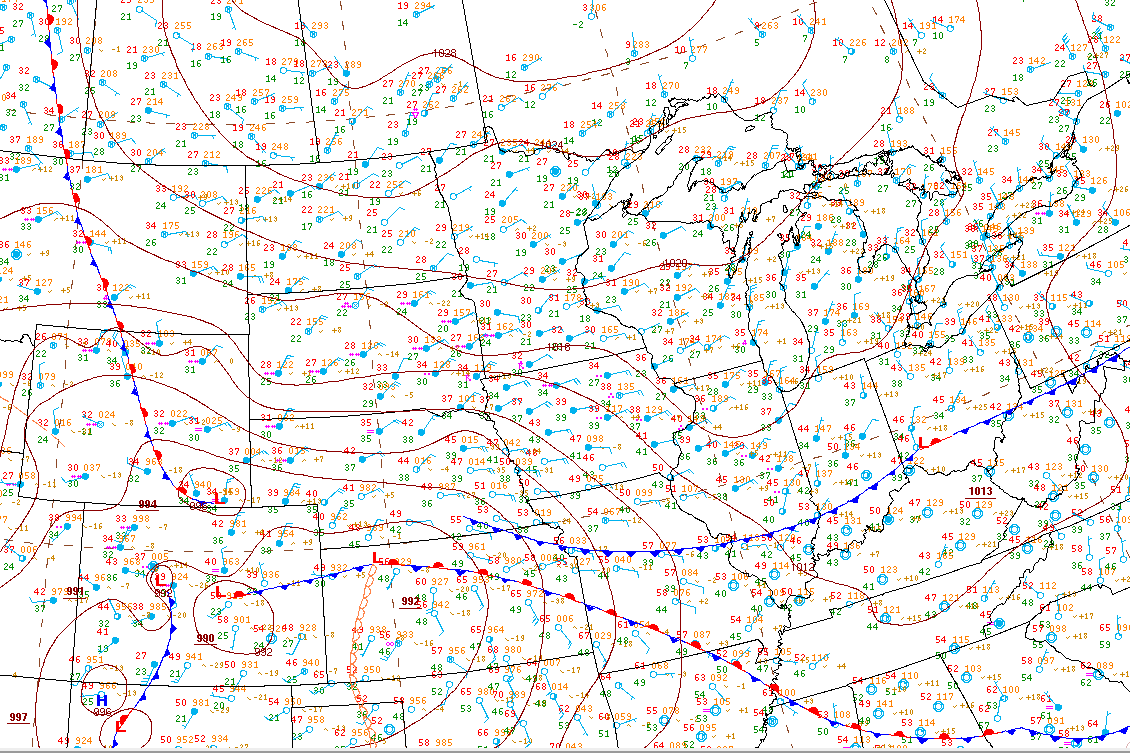 |
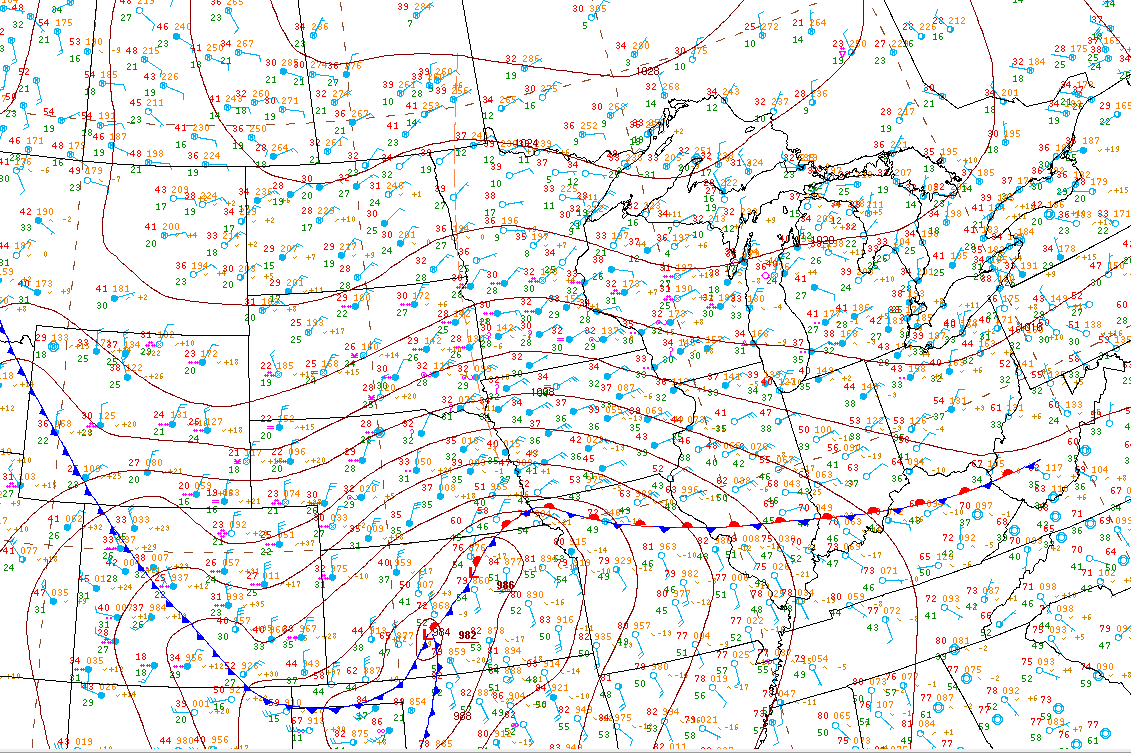 |
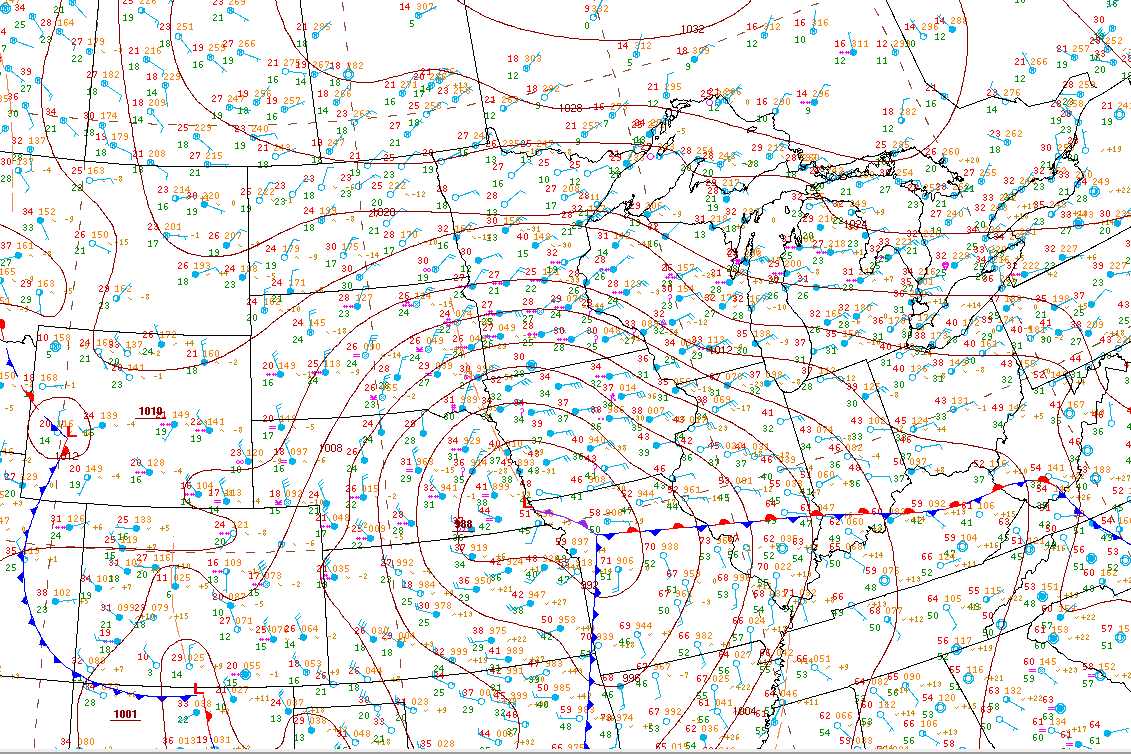 |
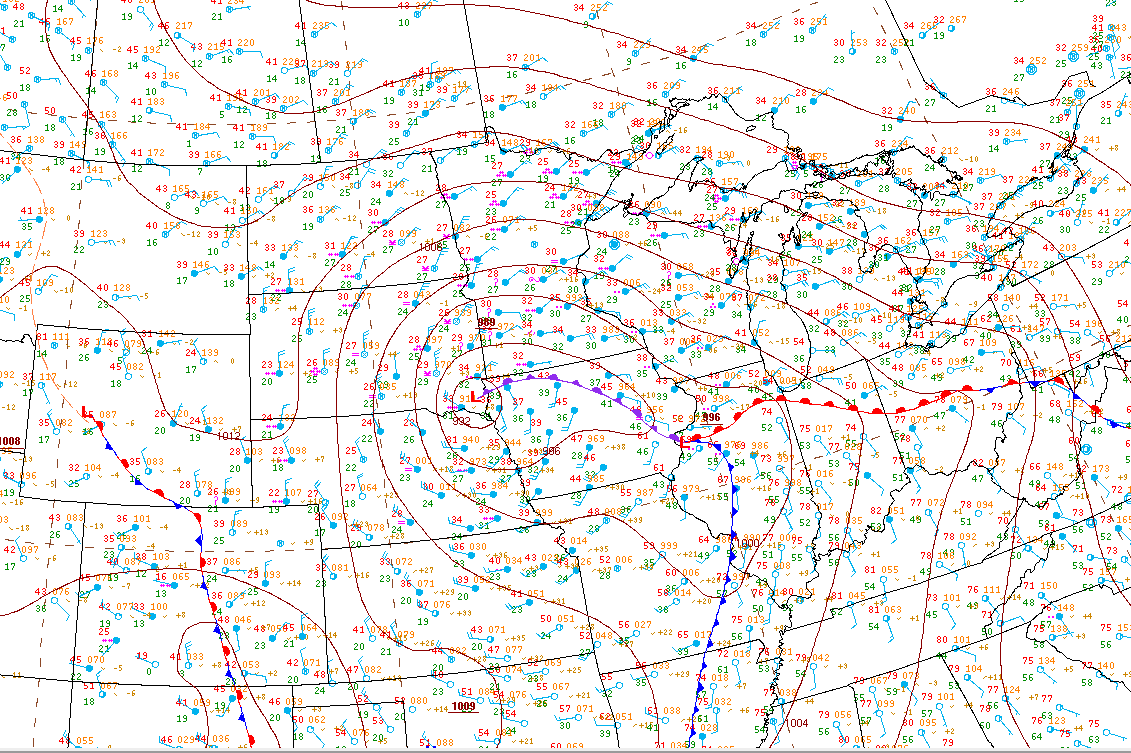 |
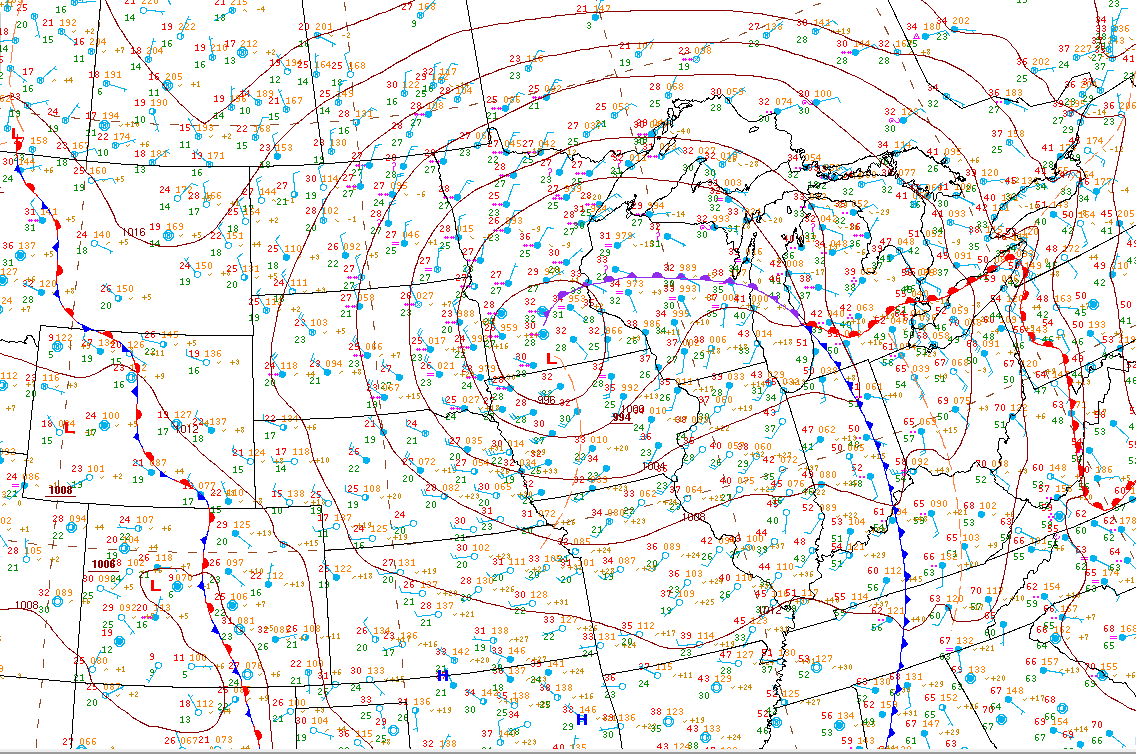 |
| 7 AM Wednesday | 7 PM Wednesday | 7 AM Thursday | 7 PM Thursday | 7 AM Friday |
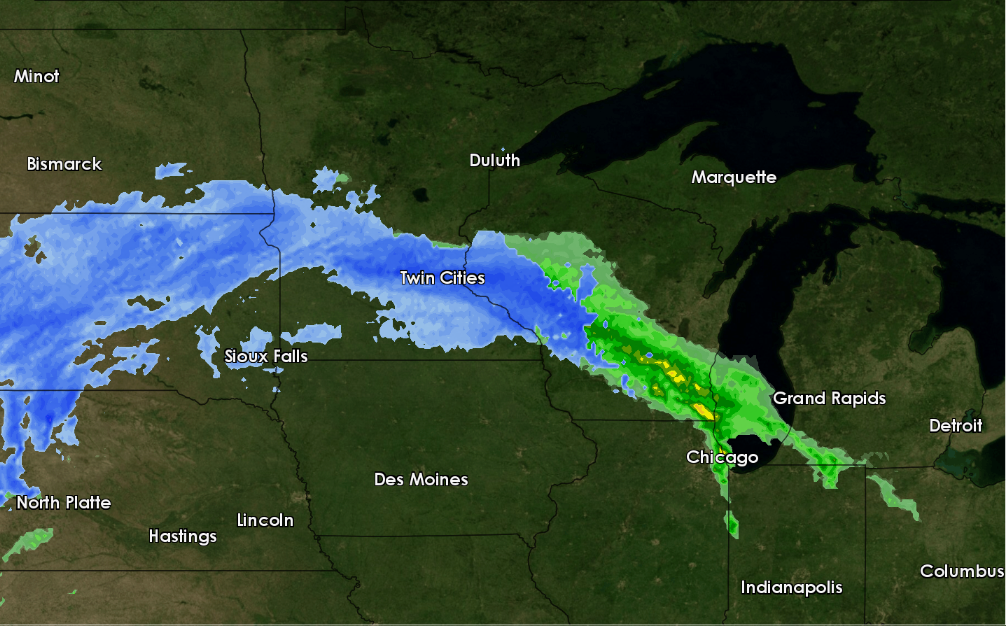 |
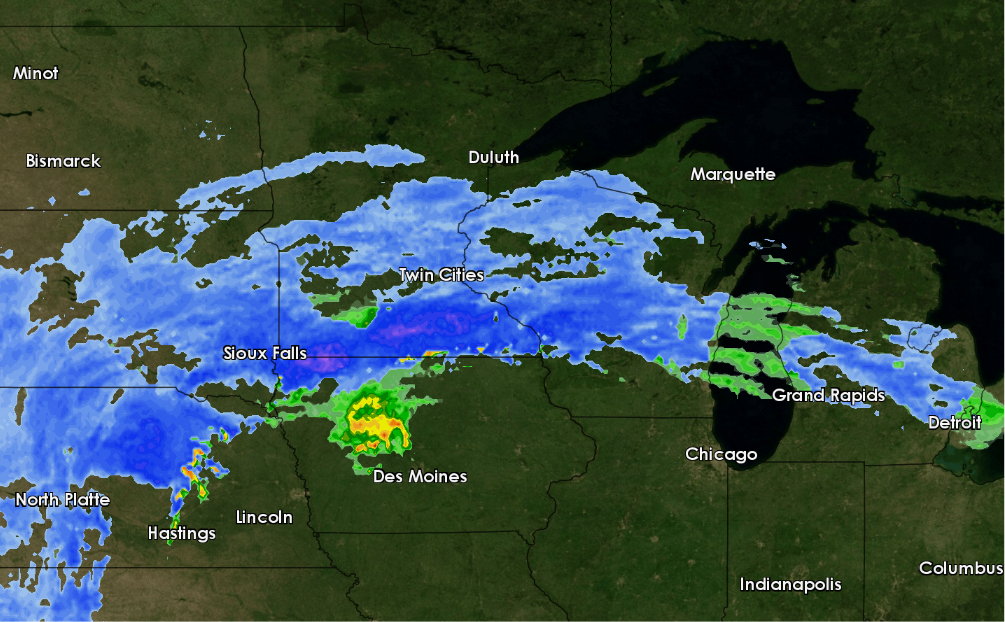 |
 |
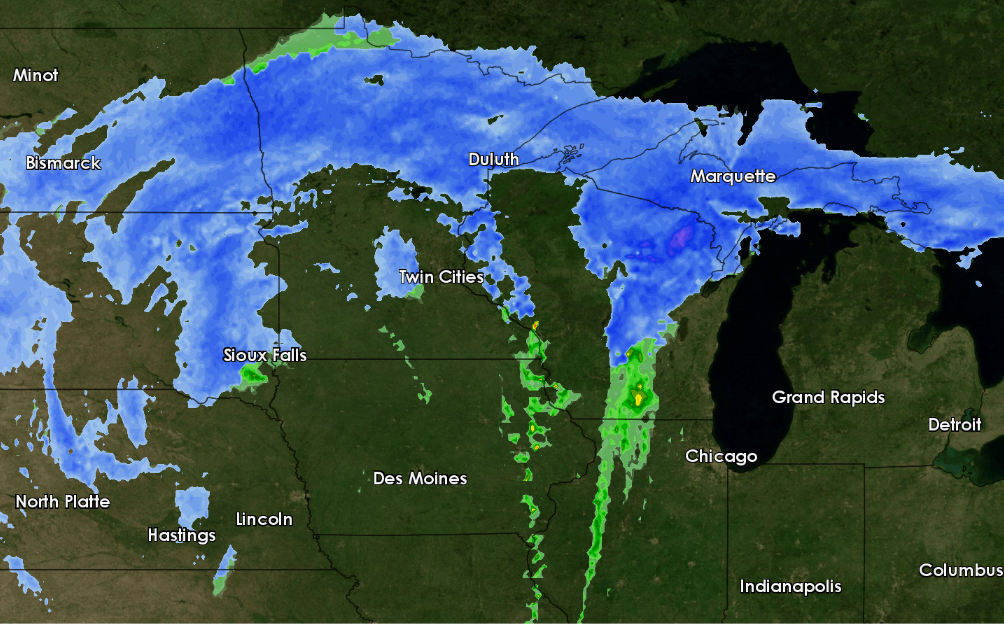 |
 |
| Winter radar reflectivity showing the first band of heavy snow lifting north slowly. Blue is snow/sleet and green is rain. (4 PM on 4/10) | Radar reflectivity showing another heavy band of snow developing overnight. (1 AM on 4/11) | Radar reflectivity showing the snow continuing during the morning of 4/11. A couple Severe Thunderstorm Warnings were issued for thunderstorms embedded in the snow across western MN producing large hail. (840 AM on 4/11) | Radar reflectivity showing the main band of snow shifting well north, but rain, snow, and sleet showers continue in waves across southern MN into WI. (5 PM on 4/11) | Radar reflectivity showing continues rain and snow showers overnight. (1 AM on 4/12) |
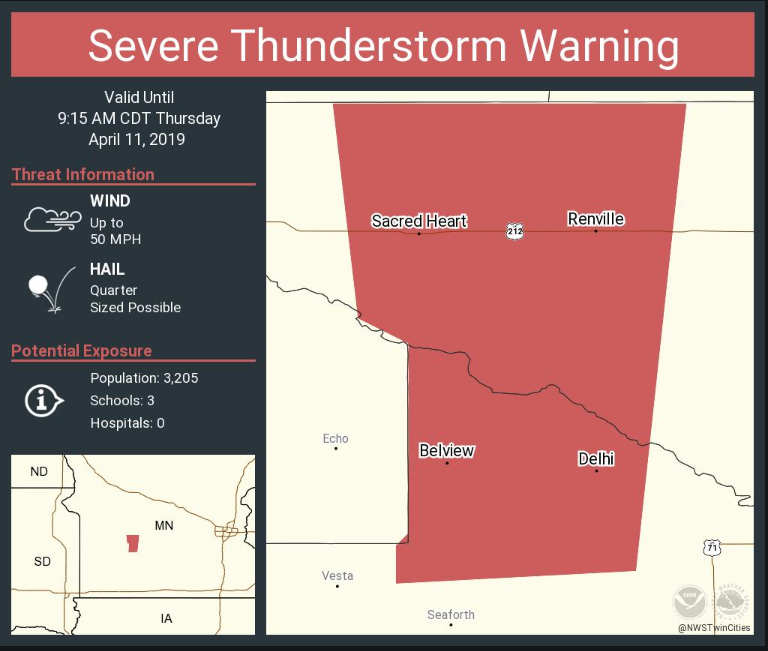 |
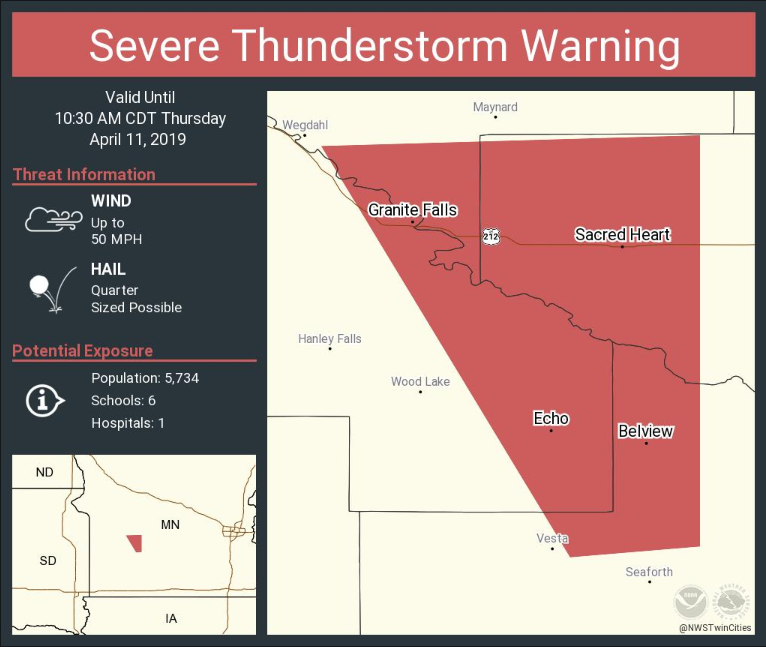 |
| The first Severe Thunderstorm Warning of the year was issued for a thunderstorm producing quarter size hail and blinding snow. | A second Severe Thunderstorm Warning was issued about an hour later for another thunderstorm producing quarter size hail and blinding snow. |
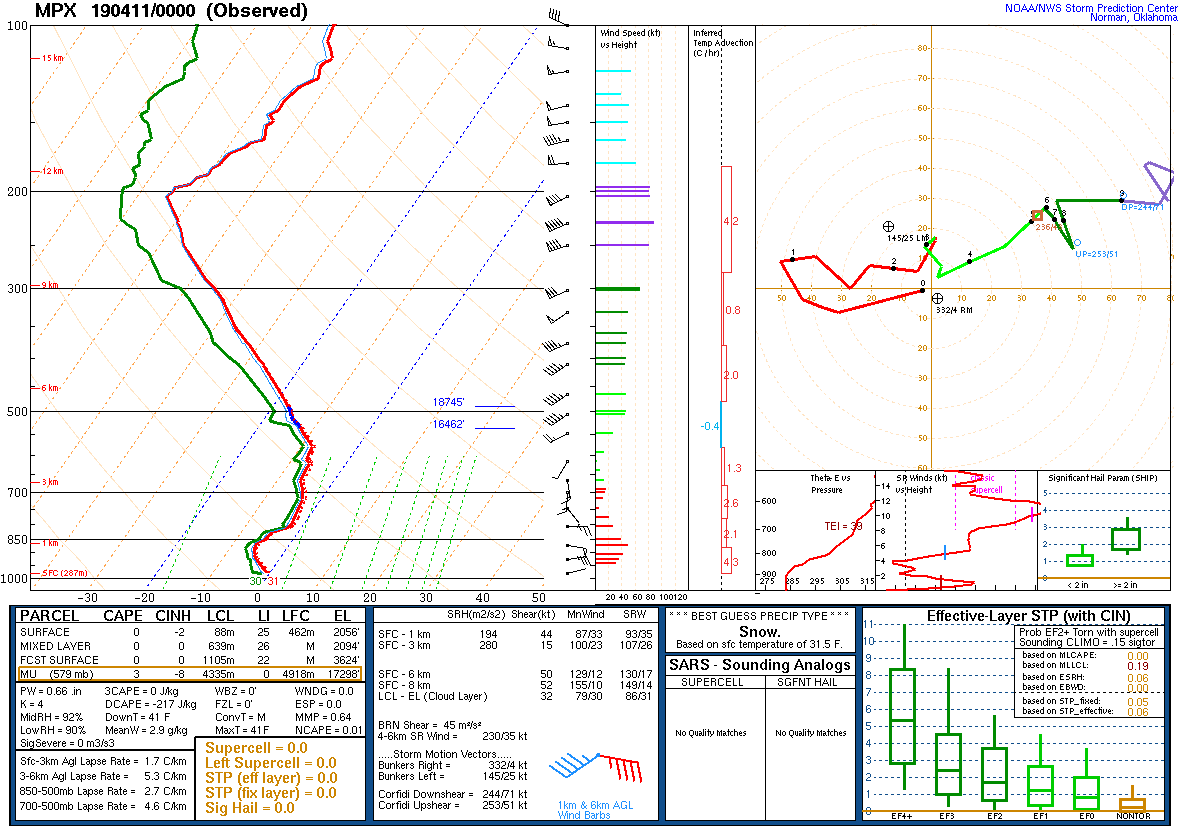 |
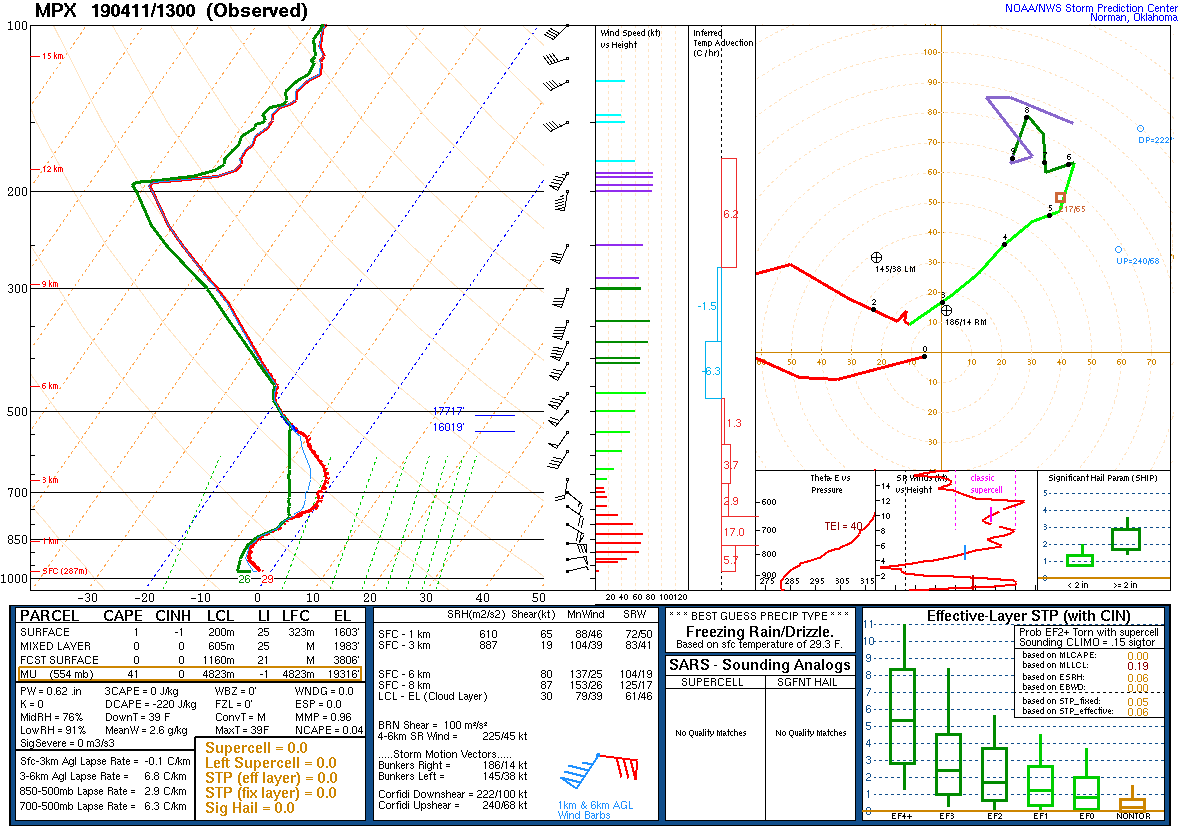 |
 |
| The sounding from 7 PM Wednesday shows a pure snow atmosphere. | The sounding from early Thursday morning shows a warm layer developing around 700 mb, but the atmosphere is still cold enough for all snow. | A special sounding taken midday Thursday shows the arrival of a very pronounced warm layer between 850-700 mb (+7C). This allowed the snow to completely melt in this layer and then refreeze into sleet in the very cold air beneath that layer before reaching the ground. |
Peak Wind Reports
...HIGHEST WIND REPORTS FROM APRIL 11TH... Location Speed Time/Date Provider ...Minnesota... ...Anoka County... Blaine AP 41 MPH 0145 PM 04/11 AWOS Wyoming 6WSW 36 MPH 0606 PM 04/11 RAWS Lino Lakes 36 MPH 0153 PM 04/11 CWOP ...Benton County... Foley 6WSW 43 MPH 0410 PM 04/11 MNDOT Rice 1NNW 41 MPH 1211 PM 04/11 MNDOT Sauk Rapids 38 MPH 0824 AM 04/11 CWOP ...Blue Earth County... Mankato AP 52 MPH 0800 AM 04/11 AWOS Mankato US-169 Mile Post 52 40 MPH 0715 AM 04/11 MNDOT ...Brown County... Springfield 36 MPH 1031 AM 04/11 CWOP New Ulm AP 33 MPH 1116 AM 04/11 AWOS ...Carver County... Victoria 51 MPH 0948 AM 04/11 CWOP Carver 3S 51 MPH 0949 AM 04/11 RAWS Mayer 1NE 50 MPH 1016 AM 04/11 MNDOT New Germany 1NW 48 MPH 1205 PM 04/11 MNDOT ...Chippewa County... Montevideo AP 46 MPH 0435 AM 04/11 AWOS ...Chisago County... Almelund 40 MPH 0132 PM 04/11 CWOP Harris 2N 38 MPH 0210 PM 04/11 MNDOT Rush City AP 37 MPH 1215 PM 04/11 ASOS Scandia 32 MPH 0150 PM 04/11 CWOP ...Dakota County... Lakeville AP 41 MPH 1035 AM 04/11 AWOS South St. Paul 1WSW 40 MPH 0845 AM 04/11 MNDOT South St. Paul AP 38 MPH 0855 AM 04/11 AWOS ...Douglas County... Alexandria AP 54 MPH 0251 PM 04/11 ASOS Alexandria 2SSE 45 MPH 0331 PM 04/11 MNDOT ...Faribault County... Easton 51 MPH 0233 PM 04/11 CWOP Minnesota Lake 45 MPH 0245 PM 04/11 CWOP ...Freeborn County... Albert Lea AP 31 MPH 0511 PM 04/11 AWOS ...Goodhue County... Cannon Falls 7SSE 55 MPH 0450 PM 04/11 MNDOT Red Wing 4W 52 MPH 0430 AM 04/11 MNDOT Stanton AP 51 MPH 0435 PM 04/11 AWOS Red Wing 37 MPH 1101 AM 04/11 CWOP Zumbrota 35 MPH 1143 AM 04/11 CWOP ...Hennepin County... Eden Prairie AP 54 MPH 0813 AM 04/11 ASOS Crystal AP 53 MPH 0136 PM 04/11 ASOS Minneapolis-St. Paul AP 51 MPH 0111 PM 04/11 ASOS Edina 50 MPH 0446 AM 04/11 CWOP Bloomington 45 MPH 0801 AM 04/11 CWOP Mound 43 MPH 0900 AM 04/11 CWOP Robbinsdale 41 MPH 1257 PM 04/11 CWOP Golden Valley 40 MPH 1000 AM 04/11 CWOP Richfield 3ESE 37 MPH 0850 AM 04/11 MNDOT Maple Grove 35 MPH 1015 AM 04/11 MNDOT ...Isanti County... Cambridge AP 33 MPH 0155 PM 04/11 AWOS Cambridge 31 MPH 0145 PM 04/11 CWOP ...Kanabec County... Mora 1ENE 42 MPH 0308 PM 04/11 RAWS Mora AP 33 MPH 0136 PM 04/11 AWOS ...Kandiyohi County... Willmar 51 MPH 1030 AM 04/11 CWOP Willmar AP 51 MPH 0956 AM 04/11 AWOS ...Lac qui Parle County... Madison AP 41 MPH 0135 PM 04/11 AWOS Marietta 5SSW 37 MPH 0820 AM 04/11 MNDOT ...Le Sueur County... New Prague 2W 43 MPH 1250 PM 04/11 MNDOT ...Martin County... Fairmont AP 49 MPH 0828 AM 04/11 AWOS ...McLeod County... Glencoe AP 44 MPH 1159 AM 04/11 ASOS Hutchinson AP 44 MPH 1159 AM 04/11 AWOS ...Meeker County... Litchfield AP 44 MPH 1116 AM 04/11 AWOS ...Mille Lacs County... Foreston 46 MPH 0206 PM 04/11 CWOP Milaca 44 MPH 1202 PM 04/11 CWOP Milaca 8N 44 MPH 0240 PM 04/11 MNDOT Princeton AP 39 MPH 1215 PM 04/11 AWOS Mns No. 1 38 MPH 0236 PM 04/11 RAWS ...Morrison County... Hillman 46 MPH 0438 PM 04/11 CWOP Harding 3WNW 42 MPH 0440 PM 04/11 MNDOT Camp Ridley 38 MPH 0423 PM 04/11 AWOS Little Falls 2SSE 33 MPH 1207 PM 04/11 RAWS Little Falls AP 30 MPH 0559 AM 04/11 AWOS ...Pope County... Starbuck 8SSW 51 MPH 0850 AM 04/11 MNDOT Glenwood AP 48 MPH 0915 AM 04/11 AWOS ...Ramsey County... St. Paul Dwtn AP 66 MPH 0852 AM 04/11 ASOS ...Redwood County... Redwood Falls AP 58 MPH 0841 AM 04/11 ASOS ...Renville County... Olivia AP 38 MPH 0815 AM 04/11 AWOS ...Rice County... Dundas 5WNW 49 MPH 0415 AM 04/11 MNDOT Northfield 46 MPH 0441 AM 04/11 CWOP ...Scott County... Lydia 55 MPH 0815 AM 04/11 CWOP Spring Lake Park 48 MPH 1230 PM 04/11 CWOP Prior Lake 36 MPH 0843 AM 04/11 CWOP ...Sherburne County... St. Cloud AP 49 MPH 1220 PM 04/11 ASOS Crescent Lake No. 1 39 MPH 0220 PM 04/11 HADS ...Sibley County... Winthrop 2W 48 MPH 1100 AM 04/11 MNDOT ...Stearns County... Belgrade 3ESE 49 MPH 1145 AM 04/11 MNDOT Paynesville AP 47 MPH 1059 AM 04/11 AWOS Sauk Centre AP 45 MPH 0915 AM 04/11 AWOS Sauk Centre 2SE 45 MPH 0315 PM 04/11 MNDOT ...Steele County... Owatonna AP 45 MPH 0352 PM 04/11 AWOS ...Stevens County... Morris AP 43 MPH 0755 AM 04/11 AWOS ...Swift County... Benson AP 43 MPH 0935 AM 04/11 AWOS Appleton AP 37 MPH 0430 AM 04/11 AWOS ...Todd County... Long Prairie AP 40 MPH 1216 PM 04/11 AWOS Staples MN (Airport) 36 MPH 1135 AM 04/11 AWOS ...Waseca County... Waseca AP 54 MPH 0315 PM 04/11 AWOS ...Washington County... Lake Elmo AP 48 MPH 0515 PM 04/11 AWOS Denmark Township 44 MPH 0445 AM 04/11 CWOP Woodbury 41 MPH 0859 AM 04/11 CWOP Lakeland 41 MPH 1225 PM 04/11 CWOP Hugo 38 MPH 0516 PM 04/11 CWOP Cottage Grove 35 MPH 0459 PM 04/11 CWOP ...Watonwan County... Madelia 36 MPH 0130 PM 04/11 CWOP St. James AP 32 MPH 0335 PM 04/11 AWOS ...Wright County... Maple Lake 48 MPH 1216 PM 04/11 CWOP Maple Lake AP 48 MPH 1135 AM 04/11 ASOS 2 WNW Dayton 42 MPH 1054 AM 04/11 CWOP Winsted 42 MPH 0954 AM 04/11 CWOP Clearwater 1SE 37 MPH 0140 PM 04/11 MNDOT ...Yellow Medicine County... Granite Falls AP 49 MPH 0435 AM 04/11 AWOS Canby AP 43 MPH 0859 AM 04/11 AWOS Hanley Falls MN-23 Mile Post 43 MPH 1000 AM 04/11 MNDOT ...Wisconsin... ...Barron County... Rice Lake AP 44 MPH 0135 PM 04/11 AWOS Cumberland AP 39 MPH 1215 PM 04/11 AWOS Chetek AP 31 MPH 0235 PM 04/11 AWOS ...Chippewa County... Eau Claire AP 54 MPH 0848 AM 04/11 ASOS Stanley 1SSE 43 MPH 0557 PM 04/11 WIDOT ...Eau Claire County... Eau Claire 37 MPH 1259 PM 04/11 CWOP Augusta 1NW 36 MPH 0305 PM 04/11 RAWS ...Pierce County... Red Wing AP 46 MPH 0956 AM 04/11 AWOS Spring Valley 37 MPH 1015 AM 04/11 CWOP ...Polk County... Osceola AP 39 MPH 1155 AM 04/11 AWOS St. Croix Falls 2ESE 39 MPH 1205 PM 04/11 WIDOT Osceola 32 MPH 1201 PM 04/11 CWOP ...Rusk County... Ladysmith 2SW 33 MPH 0105 PM 04/11 RAWS ...St. Croix County... New Richmond AP 54 MPH 1235 PM 04/11 AWOS Star Prairie 43 MPH 1008 AM 04/11 RAWS Emerald 39 MPH 0849 AM 04/11 CWOP Observations are collected from a variety of sources with varying equipment and exposures. We thank all volunteer weather observers for their dedication. Not all data listed are considered official.
Snowfall Reports
Location Amount Time/Date Provider ...Minnesota... ...Anoka County... 3 NE Ramsey 8.0 in 0700 AM 04/12 1 SE Anoka 6.0 in 0700 AM 04/12 3 NNE Ramsey 6.0 in 0700 AM 04/12 3 N Blaine 5.5 in 0700 AM 04/12 ...Benton County... 4 NNE Sartell 5.8 in 0700 AM 04/12 1 NE Rice 4.7 in 0700 AM 04/12 ...Blue Earth County... 2 ESE Mankato 9.5 in 0700 AM 04/12 ...Brown County... 6 NNW Sveadahl 8.2 in 0619 AM 04/12 1 SW Sleepy Eye 6.0 in 0800 AM 04/12 ...Carver County... Chanhassen NWS 11.4 in 0100 PM 04/12 Official NWS Obs 1 NNW Watertown 11.0 in 0415 AM 04/12 2 WSW Victoria 9.8 in 0700 AM 04/12 1 WSW Carver 8.5 in 0700 AM 04/12 2 WSW Excelsior 7.3 in 0800 AM 04/12 2 N Chaska 7.3 in 0630 AM 04/12 ...Chippewa County... Montevideo 17.0 in 0700 AM 04/12 ...Dakota County... 2 NE Northfield 11.1 in 0700 AM 04/12 2 SW Apple Valley 10.1 in 0700 AM 04/12 2 SE Rosemount 9.5 in 0800 AM 04/12 2 SW Rosemount 9.0 in 0700 AM 04/12 3 WSW Lakeville 8.6 in 0200 AM 04/12 3 SE Apple Valley 8.3 in 0720 AM 04/12 3 N Vermillion 7.0 in 0700 AM 04/12 1 NW Hastings 7.0 in 0700 AM 04/12 ...Douglas County... 1 NNE Carlos 10.0 in 0559 AM 04/12 2 W Carlos 10.0 in 0530 AM 04/12 6 ESE Millerville 6.0 in 0800 AM 04/12 ...Faribault County... 1 WNW Winnebago 3.0 in 0800 AM 04/12 1 S Blue Earth 2.6 in 0700 AM 04/12 ...Freeborn County... 3 NNW Glenville 3.0 in 0700 AM 04/12 ...Goodhue County... Cannon Falls 11.6 in 0800 AM 04/12 4 E Nerstrand 9.6 in 0700 AM 04/12 5 NNE Vasa 7.9 in 0700 AM 04/12 ...Hennepin County... Minneapolis St. Paul Airport 9.8 in 0700 PM 04/12 Official NWS Obs 1 N Maple Grove 9.5 in 0425 PM 04/11 2 NE Edina 9.0 in 0700 AM 04/12 0.4 NE Minneapolis 8.8 in 0700 AM 04/12 COCORAHS 1 SE Golden Valley 8.4 in 0700 AM 04/12 3 SSE Edina 8.1 in 0700 AM 04/12 2 NNW Osseo 7.5 in 0800 AM 04/12 2 SW Champlin 7.2 in 0700 AM 04/12 3 WSW Long Lake 7.0 in 0745 AM 04/12 2 ESE Eden Prairie 6.8 in 0905 AM 04/12 1 NE Maple Grove 6.5 in 0730 AM 04/12 2 SW Fridley 6.3 in 0700 AM 04/12 Robbinsdale 6.2 in 0700 AM 04/12 ...Kanabec County... 1 WNW Mora 3.0 in 0700 AM 04/12 ...Kandiyohi County... 8 SE Sunburg 9.1 in 0700 AM 04/12 5 N Willmar 7.8 in 0700 AM 04/12 4 WSW Spicer 6.0 in 0830 AM 04/12 ...Lac qui Parle County... Madison 20.0 in 0900 AM 04/12 ...Le Sueur County... 1 S New Prague 12.5 in 0700 AM 04/12 6 NNW Le Center 9.0 in 0800 AM 04/12 ...Martin County... 1 ESE Fairmont 1.1 in 0700 AM 04/12 ...McLeod County... 1 ESE Brownton 14.0 in 0800 AM 04/12 Glencoe 9.5 in 0800 AM 04/12 1 W Hutchinson 8.3 in 0700 AM 04/12 ...Meeker County... 1 W Dassel 11.1 in 0700 AM 04/12 3 WSW Watkin 8.8 in 0900 AM 04/12 COCORAHS ...Mille Lacs County... 2 NW Foreston 5.0 in 0114 PM 04/12 Onamia 4.7 in 0700 AM 04/12 2 SE Milaca 4.0 in 0700 AM 04/12 1 SSW Milaca 4.0 in 0730 AM 04/12 ...Morrison County... 1 SW Little Falls 10.0 in 0700 AM 04/12 5 E Camp Ripley 6.0 in 0700 AM 04/12 7 N Camp Ripley 5.9 in 0700 AM 04/12 ...Nicollet County... 3 ESE New Ulm 9.2 in 0700 AM 04/12 ...Ramsey County... 1 NW North St. Paul 9.8 in 0700 AM 04/12 1 SSE Roseville 9.0 in 0700 AM 04/12 Falcon Heights 8.2 in 0800 AM 04/12 1 N North St. Paul 8.0 in 0456 PM 04/11 ...Redwood County... Belview 9.1 in 0655 AM 04/12 1 NE Redwood Falls 8.8 in 0700 AM 04/12 ...Renville County... 7 SSE Bird Island 13.1 in 0700 AM 04/12 Bird Island 11.5 in 0650 AM 04/12 2 WNW Danube 8.5 in 0700 AM 04/12 ...Rice County... 1 N Faribault 7.5 in 0700 AM 04/12 3 ENE Montgomery 7.0 in 0500 AM 04/12 1 WNW Veseli 7.0 in 0500 AM 04/12 ...Sherburne County... St. Cloud Airport 8.3 in 0100 PM 04/12 Official NWS Obs 6 E St. Cloud 7.3 in 0700 AM 04/12 3 SE Orrock 6.0 in 0700 AM 04/12 ...Sibley County... 2 WNW Green Isle 13.5 in 0700 AM 04/12 ...Stearns County... 7 SE Pleasant Lake 10.0 in 0135 PM 04/12 7 W Clearwater 10.0 in 1140 AM 04/12 5 S St. Cloud 10.0 in 1009 AM 04/12 7 SE Pleasant Lake 9.5 in 0940 AM 04/12 7 SE Pleasant Lake 9.0 in 0604 PM 04/11 Melrose 8.5 in 0700 AM 04/12 Kimball 8.3 in 1151 AM 04/12 2 SSW Paynesville 8.0 in 0700 AM 04/12 2 NE Waite Park 7.1 in 0100 AM 04/12 Kimball 6.0 in 0606 AM 04/12 1 SSE Sartell 5.9 in 0700 AM 04/12 2 SSW Paynesville 5.5 in 0700 AM 04/12 4 S St. Stephen 5.0 in 0900 AM 04/12 ...Steele County... Ellendale 7.4 in 0700 AM 04/12 1 ENE Owatonna 7.0 in 0630 AM 04/12 1 NNW Owatonna 5.0 in 0800 AM 04/12 ...Stevens County... 3 NW Donnelly 12.9 in 0700 AM 04/12 2 E Morris 11.0 in 0800 AM 04/12 ...Swift County... 7 N Holloway 12.0 in 0700 AM 04/12 1 WNW Benson 10.6 in 0700 AM 04/12 ...Todd County... 1 N Hewitt 7.1 in 0800 AM 04/12 1 WSW Long Prairie 5.5 in 0700 AM 04/12 ...Waseca County... 1 NE Waseca 6.8 in 0700 AM 04/12 ...Wright County... 2 WNW Hanover 13.5 in 0800 AM 04/12 1 E St. Michael 8.1 in 0630 AM 04/12 Buffalo 6.8 in 0342 PM 04/11 5 NNE Maple Lake 6.7 in 0440 PM 04/11 Rockford 6.6 in 0700 AM 04/12 ...Yellow Medicine County... Canby 17.0 in 0800 AM 04/12 COOP Granite Falls 13.0 in 0630 PM 04/11 ...Wisconsin... ...Barron County... Cumberland 5.0 in 0700 AM 04/12 2 SE Chetek 4.5 in 0700 AM 04/12 1 NW Cameron 4.5 in 0800 AM 04/12 Haugen 4.0 in 1152 AM 04/12 ...Chippewa County... 1 ESE Chippewa Falls 11.5 in 0700 AM 04/12 1 S Chippewa Falls 10.3 in 0700 AM 04/12 7 NE Tilden 8.3 in 0630 AM 04/12 4 NNE Cornell 6.0 in 0700 AM 04/12 ...Dunn County... Menomonie 9.5 in 0700 AM 04/12 3 SSW Wheeler 8.1 in 0630 AM 04/12 Elk Mound 8.0 in 0700 AM 04/12 ...Eau Claire County... Eau Claire 11.4 in 0700 PM 04/12 ...Pepin County... 1 SW Durand 7.0 in 0700 AM 04/12 ...Pierce County... 1 SW River Falls 9.0 in 0730 AM 04/12 1 E Ellsworth 9.0 in 0700 AM 04/12 3 SE River Falls 8.0 in 0630 PM 04/11 1 S River Falls 7.0 in 0700 AM 04/12 ...Polk County... 1 WSW Luck 5.5 in 0700 AM 04/12 3 E Nye 4.2 in 0800 AM 04/12 5 SSE Balsam Lake 4.0 in 0700 AM 04/12 ...Rusk County... 3 WNW Ladysmith 4.9 in 0700 AM 04/12 2 ESE Bruce 3.6 in 0700 AM 04/12 ...St. Croix County... 1 WSW Baldwin 9.5 in 0700 AM 04/12 1 SSW Roberts 5.7 in 0800 AM 04/12 Observations are collected from a variety of sources with varying equipment and exposures. We thank all volunteer weather observers for their dedication. Not all data listed are considered official.
 |
Media use of NWS Web News Stories is encouraged! Please acknowledge the NWS as the source of any news information accessed from this site. |
 |